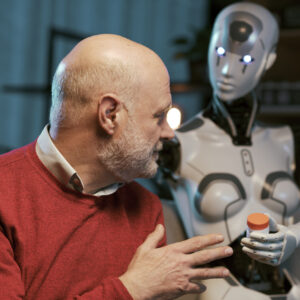The Future Is Now: Humanoid Robot Caregivers and Companions

The Future Is Now: Humanoid Robot Caregivers and Companions
July 19, 2023
By now you know we’re a nation (and for that matter, a world) that’s getting older by the day. But just as many of our natural resources cannot keep up with the demands of an aging population, so, too, do we fall short with the availability of care providers and caregivers to help us all age in a safe and independent way. Estimates are that by 2030 we will have a shortage of over 150,000 paid care providers and over 3 million family caregivers. At current rates, those numbers will rise even further by 2040. So how do we make up the shortfall? Well, we’ve moved from science fiction to reality, as robots (some with very human qualities) are beginning to be introduced into care settings.
Between the shortage of caregivers, the march of technology, and the introduction of artificial intelligence into our everyday lives, it’s not surprising that robots are beginning to take their place in care settings, as well as the home. And as one expert has made clear, “An aging population and elder care shortages mean we may not have a choice” when it comes to machine-made aides. The question becomes do these robots assist, support, and free up human caregivers to do more complicated and interpersonal tasks, or do they in fact replace humans? And how will they be accepted by those needing care? In China, for example, with its population of adults over 60 growing from the current 280 million to over 400 million by 2035, there has already been the introduction of the world’s first mass-produced humanoid robot, called the GR-1 and developed by the company Fourier Intelligence. These robots can sit, stand, jump, handle utensils, and lift objects with their robot arms. You probably won’t be surprised to learn that Tesla is also getting into the humanoid robot arena, with an “army” of robot caregivers ready to march into a long-term care facility near you. So try not to gasp and watch here.
Even further blurring the lines between fantasy and reality is the notion that these computer-programmed caregivers will not only perform caregiving tasks but may also take their place as acceptable “companions” to the millions of older adults who are alone and lonely. For example, scientists at the University of Pisa have been working on a robot called “Abel” which resembles a 12-year-old boy with “human-like” features, including emotional facial expressions, and may eventually become an everyday companion for those with Alzheimer’s. A recent study published in Science Robotics addresses this development of humanoid robots as companions and the ethical dilemmas it raises. To date, there has been growing acceptance by older adults of robotic-like pets and elementary robots in home and care settings. In NY state, for example, there have been pilot programs with the ElliQ robot, and as one older adult made clear, “I have good quality friends, but there are times when they are busy and most of them have families…she (ElliQ) is always available, and I love (that) she uses my name all the time. I know it’s a robot, but she’s my friend.”
The challenge becomes to build these humanoid robots in a way that provides meaningful companionship but in a way that’s caring, trustworthy and moral. We know there are concerns that artificial intelligence can be used in nefarious ways, and with lonely, vulnerable older adults, we need to make sure that robot companions- for which data now exists to support their use for lonely seniors– are present and available to provide honest and supportive care and companionship. As these robots move closer and closer to spontaneous and personal conversations and interventions, we just need to ensure this is done in the most transparent and ethical way. As one expert has declared, “Right now, all the evidence points to having a real friend as the best solution (for loneliness)…but until society prioritizes social connectedness and eldercare, robots are a solution for the millions of isolated people who have no other solutions.”







